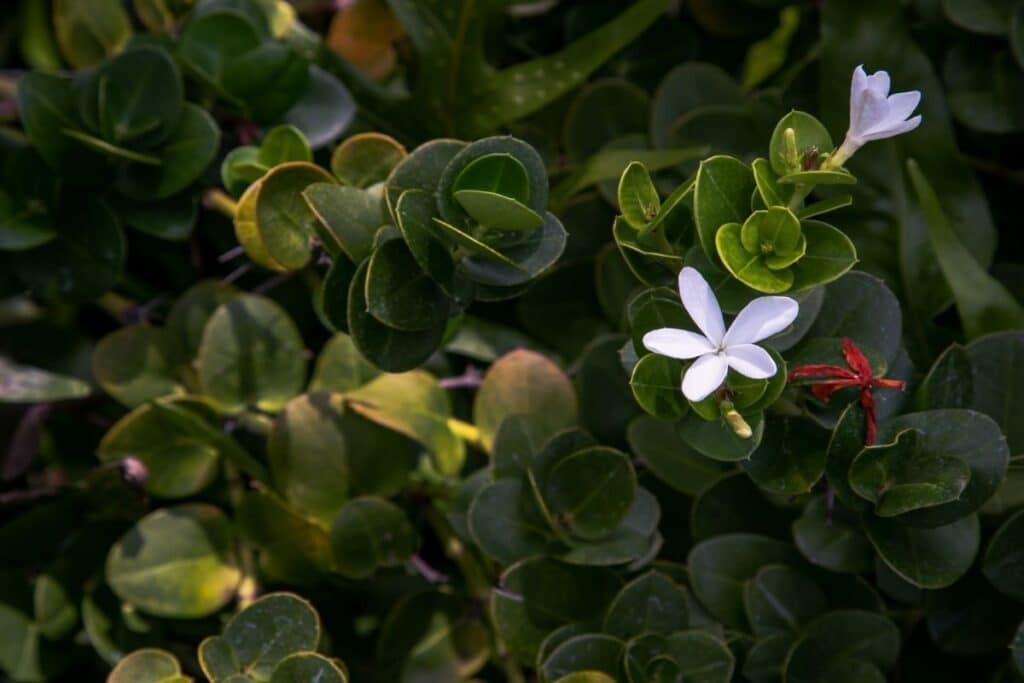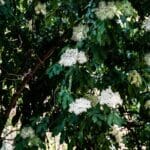Carissa is a great hedging or groundcover plant for coastal areas in Florida, California, and other warm places throughout the globe. This evergreen grows fast, needs little care, and produces deep green foliage, attractive fragrant orange blossoms, and edible fruit.
Read on to learn more about growing and caring for these under-used plants.
What Is A Carissa Shrub?
Natal plum, or large num-num as it is also known, is a thorny ornamental shrub from the Apocynaceae (dogbane) family.
Carissa macrocarpa is a woody evergreen with a dense and rounded growth form and many branches. This plant reaches a maximum height of about 13 feet (3.9m), and nearly as wide. Dwarf, spreading selections have been developed that reach just a foot or two (0.3-0.6m) in height.
This plant originates from sandy coastal forests and thickets. It occurs naturally in the southeast of Africa in coastal areas of South Africa and Mozambique.
The foliage consists of somewhat glossy, oppositely arranged leaves that are oval to rounded and measure 2 to 4 inches (5-10cm) in length. They are a deep green color and are slightly paler below, with a firm leathery texture and a pointed tip.
These are spiny plants that have characteristic, Y-shaped double thorns, and although the stems and branches may look green and soft, they are in fact sturdy and woody. Cutting the leaves, stems, or fruits of this plant reveals a milky white substance (latex).
Carissa Flowers
The natal plum bush produces lovely white flowers that have 5 petals and are mildly, but very pleasantly, scented like the blossoms of a citrus tree. These star shaped flowers can reach nearly 1 ½ inches (38mm) across and are produced throughout the year, but perform best in spring, and into the heat of mid-summer.
Red to purplish fruits that resemble plums add to the appeal of this species. Very often, the fruits and flowers, along with new growth, are visible at the same time. Although these plants are not particularly showy, the natal plum flowers and ripe fruit create a lovely contrast with the dark green leaves.
Other Carissa Species And Varieties
Carissa macrocarpa was formerly known as C. grandiflora, and might still be advertised or described as such in various publications and catalogs. Much work was done with these natal plums to develop better fruiting selections. As this lost favor, and many gardeners began to show a preference for smaller, more compact shrubs, some great dwarf cultivars have been developed.
Some great options include:
- ‘Green Carpet’- this low-growing, spreading variety is an ideal form for an evergreen groundcover. This is a great choice for coastal areas. These plants reach a height of about 15 inches (37.5cm) while spreading to about 4 feet (1.2m).
- ‘Boxwood Beauty’- this is also a dwarf spreading form but has a more mounded growth form, making it great for container planting and for borders and foundations. This form has far fewer thorns than the wild type. It grows to 2 or 3 feet tall (0.6-0.9m).
- ‘Nana’ – This dwarf form has no thorns and is a popular bonsai specimen. It grows to just 18 inches (45cm) tall and wide.
Growing Natal Plum Plant
The best way to grow new natal plum plants is from seeds, which take about 2 weeks to germinate. The large flat seeds can be collected from ripe fruits and grown in trays in the fall or spring.
These plants can also be successfully propagated from stem cuttings. Semi-ripe cuttings taken in the summer show the best results.
These plants grow well in a variety of soils, although there is a definite preference for well-drained substrates. Consider mixing some organic material, such as peat moss, into the planting site if you have very poor sandy soil.
Carissa macrocarpa comes from a fairly well-watered and humid climate so they should be watered regularly in dry climates for best growth. This is where a free draining medium will come in handy to prevent the plants from having ‘wet feet’.
These plants will do best in full sun to light shade. Plants grown in shady areas will survive but develop a thin, leggy growth form.
This plant is sensitive to frost and is considered hardy to USDA zones 9 and 11. This is a great plant for coastal areas because it is tolerant of salt soils and spray, and it grows fine in windy areas.
Some plants have been killed off to the ground by cold weather and then successfully re-sprouted, but it is better to avoid exposing these plants to frost. A great option for gardeners in colder climates is to grow one of the dwarf forms in a container, and then move the plant indoors during the cold seasons.
Care And Maintenance
These are moderate to fast-growing shrubs, depending on where they are grown. They have a naturally rounded form but take well to pruning. Dwarf forms can revert to the larger wild type if not pruned regularly.
Care should be taken when pruning since the thorns are very sharp. If there is much work to be done, go ahead and wear a pair of overalls, and a heavy pair of gloves to be on the safe side.
Because the Natal plum prefers a somewhat acidic climate, feed with an acid fertilizer like Miracid every two weeks during development. During the winter, reduce feeding to once a month.
This is particularly advised in areas with alkaline soils. Carissa macrocarpa plants grown in containers should be brought indoors during cold weather if grown in cool climates. The extensive root system of this species allows it to absorb water and nutrients efficiently, making it a great choice for gardens with well draining soil.
The natal plum is generally very pest-resistant. Pests like spider mites, thrips, and whiteflies can affect young plants, however. Potential disease problems include leaf spot, blight, and root rot.
Uses
Horticultural Uses
The natal plum is a spiny shrub that makes a great security hedge or screen if planted at 3-6 foot (0.9-1.8m) spacing. There are smaller varieties that grow well in containers and this plant also makes a fantastic bonsai subject.
Low-growing forms like ‘Green Carpet’ make a great groundcover. Whatever the application, make sure you position this plant in low-traffic areas to prevent any accidental contact with its sharp spines.
Human Uses
The red fruits of Carissa macrocarpa are edible and often delicious, tasting somewhat like cranberries. The fruits are filled with a milky white substance, like that found in figs. The taste does vary from plant to plant, however.
They are rich in vitamins and minerals and can be eaten raw or made into jams and jellies. Only ripe fruits are safe to eat, and green fruits should be avoided.
Wildlife Uses
Fruit-eating birds and pollinators like butterflies are attracted to this plant.
FAQs
Are Natal plums self pollinating?
Yes, Natal plums (Carissa macrocarpa) are generally self-pollinating, meaning they can produce fruit without the need for cross-pollination by another plant. However, having multiple plants may enhance fruit production.
How do you prune Natal plums?
Pruning Natal plums involves removing dead or damaged branches and shaping the plant to maintain a desired form. Additionally, you can prune to control the size and encourage bushier growth. Pruning is typically done in late winter or early spring.
Is Natal plum plant toxic to dogs?
Yes, the Natal plum plant is considered mildly toxic to dogs. The plant contains compounds, such as alkaloids and glycosides, which can be harmful if ingested. It’s advisable to keep Natal plum plants out of reach of pets and to be cautious if planting them in areas where dogs have access.
Conclusion
Natal plum is a wonderful and easy-to-grow ornamental evergreen shrub, particularly for warm, subtropical areas in Zones 9 to 11. The delicious fruits are just the ‘cherry on top’, but remember, watch out for the thorns!
References
References
- Carolus, B. South African National Biodiversity Institute: Carissa Macrocarpa.
http://pza.sanbi.org/carissa-macrocarpa
- Morton, J. Fruits Of Warm Climates: Carissa Macrocarpa
https://hort.purdue.edu/newcrop/morton/carissa.html
- North Carolina Extension Gardener: Carissa Macrocarpa
https://plants.ces.ncsu.edu/plants/carissa-macrocarpa/
- Gilman, E. F. Carissa Grandiflora: Natal Plum, Common Carissa
https://edis.ifas.ufl.edu/publication/FP107
Close
*image by [email protected]/depositphotos







